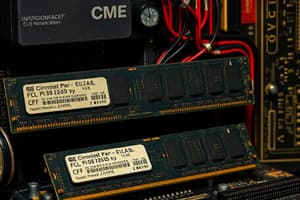Podcast
Questions and Answers
What is the primary function of the Central Processing Unit (CPU)?
What is the primary function of the Central Processing Unit (CPU)?
- Connects all components
- Provides power to components
- Executes instructions from software (correct)
- Stores data permanently
Random Access Memory (RAM) retains data even when the power is off.
Random Access Memory (RAM) retains data even when the power is off.
False (B)
Name one type of storage device that is faster than a Hard Disk Drive (HDD).
Name one type of storage device that is faster than a Hard Disk Drive (HDD).
Solid State Drive (SSD)
The ________ connects all components of a computer and houses the CPU and memory.
The ________ connects all components of a computer and houses the CPU and memory.
Match the following computer components with their functions:
Match the following computer components with their functions:
Which of the following components is usually housed within the computer case?
Which of the following components is usually housed within the computer case?
All types of computers use the same components.
All types of computers use the same components.
What is the purpose of input devices?
What is the purpose of input devices?
A ________ is a type of storage that retains data permanently and contains firmware.
A ________ is a type of storage that retains data permanently and contains firmware.
Which type of memory is considered volatile?
Which type of memory is considered volatile?
Flashcards are hidden until you start studying
Study Notes
Definition
- Computer Hardware: The physical components of a computer system.
Main Components
-
Central Processing Unit (CPU)
- The brain of the computer.
- Executes instructions from software.
- Measured in GHz (gigahertz).
-
Motherboard
- The main circuit board.
- Connects all components.
- Houses CPU, memory, and expansion slots.
-
Memory
- RAM (Random Access Memory):
- Temporary storage for active processes.
- Volatile memory; data is lost when power is off.
- ROM (Read-Only Memory):
- Permanent storage.
- Contains firmware.
- RAM (Random Access Memory):
-
Storage Devices
- Hard Disk Drive (HDD):
- Magnetic storage.
- Higher capacity, slower than SSD.
- Solid State Drive (SSD):
- Flash memory storage.
- Faster than HDD, more durable.
- Hard Disk Drive (HDD):
-
Power Supply Unit (PSU)
- Converts electricity from an outlet to usable power for components.
- Provides necessary voltage levels.
-
Input Devices
- Devices that allow users to interact with the computer.
- Examples: keyboard, mouse, scanner.
-
Output Devices
- Devices that convey information from the computer to the user.
- Examples: monitor, printer, speakers.
-
Graphics Processing Unit (GPU)
- Handles rendering of images and videos.
- Important for gaming and graphic design.
-
Cooling Systems
- Maintain optimal operating temperatures.
- Types: air cooling (fans), liquid cooling.
Additional Components
- Network Interface Card (NIC): Connects the computer to a network.
- Expansion Cards: Additional functionality (sound cards, additional USB ports).
- Case/Chassis: Houses all hardware components.
Types of Computers
- Desktops: Stationary, larger components.
- Laptops: Portable, integrated components.
- Tablets: Touchscreen interface, compact design.
- Servers: Powerful systems for managing network resources.
Key Concepts
- Compatibility: Components must be compatible with the motherboard and each other (e.g., CPU socket types).
- Upgradeability: Ability to replace or add components for better performance.
- Performance Metrics: Speed, capacity, and power efficiency are critical for assessing hardware.
Definition
- Computer Hardware: Physical components that make up a computer system.
Main Components
- Central Processing Unit (CPU): Acts as the brain, executing software instructions, and is measured in GHz (gigahertz).
- Motherboard: The primary circuit board that connects and houses CPU, memory, and expansion slots for other components.
- Memory:
- RAM (Random Access Memory): Temporary, volatile storage for active processes, losing data when power is off.
- ROM (Read-Only Memory): Permanent storage for firmware.
- Storage Devices:
- Hard Disk Drive (HDD): Uses magnetic storage, offers higher capacity but is slower than SSD.
- Solid State Drive (SSD): Features flash memory storage; it's faster and more durable compared to HDD.
- Power Supply Unit (PSU): Transforms electricity from outlets into usable power for computer components, supplying necessary voltage levels.
- Input Devices: Allow user interaction with computers; examples include keyboards, mice, and scanners.
- Output Devices: Convey information from the computer to the user, including monitors, printers, and speakers.
- Graphics Processing Unit (GPU): Responsible for rendering images and videos, crucial for gaming and graphic design.
- Cooling Systems: Ensure optimal operating temperatures through air cooling (fans) and liquid cooling systems.
Additional Components
- Network Interface Card (NIC): Facilitates network connections for the computer.
- Expansion Cards: Provide additional functionalities like sound cards and extra USB ports.
- Case/Chassis: Encloses all hardware components, providing protection and organization.
Types of Computers
- Desktops: Larger, stationary computers with individual components.
- Laptops: Portable computers with integrated components for mobility.
- Tablets: Compact devices featuring a touchscreen interface.
- Servers: High-performance systems designed for resource management on networks.
Key Concepts
- Compatibility: Ensures components work together, particularly regarding CPU socket types and motherboard specifications.
- Upgradeability: The potential for replacing or enhancing components to improve computer performance.
- Performance Metrics: Critical assessment factors include speed, storage capacity, and power efficiency of hardware components.
Studying That Suits You
Use AI to generate personalized quizzes and flashcards to suit your learning preferences.




